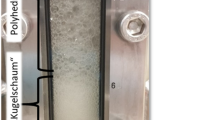Abstract
Spores of Frankia strain ACN1AG, immobilized in calcium alginate beads, germinated to produce colonies that increased in protein content and showed nitrogenase activity. Air dried immobilized spores remained viable for at least 15 days in dry condition, making the storage and transport of Frankia strains easy. This also opens the possibility of using beaded spores as inocula.
Similar content being viewed by others
References
Baker D D and O'Keefe D 1984 A modified sucrose fractionation procedure for the isolation of frankiae from actinorhizal root nodules and soil samples. Plant and Soil 78, 23–28.
Bashan Y 1986 Alginate beads as synthetic inoculant carriers for slow-release of bacteria that affect plant growth. Appl. Environ. Microbiol. 51, 1089–1098.
Benoist P, Muller A, Diem H G and Schwencke J 1992 High molecular-mass multicatalytic proteinase complexes produced by the nitrogen fixing actinomycete Frankia strain. Br. J. Bacteriol. 174, 1495–1504.
Bradford M M 1976 A rapid and sensitive method for the quantification of microgram quantities of protein utilizing the principle of protein-dye binding. Anal. Biochem. 72, 248–254.
Brouers M and Hall D O 1986 Ammonia and hydrogen production by immobilized cyanobacteria. J. Biotechnol. 3, 307–321.
Diem H G, Duhoux E, Simonet P and Dommergues Y R 1988 Actinorhizal symbiosis biotechnology: The present and future. In Proceedings of the 8th International Biotechnology Symposium. Eds. G Durand, L Bobichon and J Florent. Vol. 2, pp 984–995. Societe Francaise Microbiologie, Paris, France.
Diem H G, Ben Khalifa K, Neyra M and Dommergues Y R 1989 Recent advances in the inoculant technology with special emphasis on plant symbiotic microorganism. In Advanced Technologies for Increased Agricultural Production. Eds. U Leon, G Rialdi and R Vanore. pp 186–210. CNR-USG Italy Santa Margherita Ligure, Italy.
Froini L, Le Roux C, Dommergues Y R and Diem H G 1994 Inoculant made of encapsulated Frankia: assessment of Frankia growth within alginate beads. World J. Microbiol. Biotechnol. 10, 118–121.
Ganesh G 1993 Study of genetic diversity of Frankia alni strains isolated from Alnus nepalansis root nodules found in Meghalaya. PhD thesis. NEHU, Shillong, India.
Lalonde M 1979 A simple and rapid method for the isolation, cultivation in vitro and characterization of Frankia strains from Alnus root nodules. In Symbiotic Nitrogen Fixation for Use in Temperate Forestry. Eds. J C Gordon, C T Wheeler and D A Perry. p 480. Oregon State University, Coryallis, USA.
Normand P and Lalonde M 1986 The genetics of actinorhizal Frankia: a review. Plant and Soil 90, 429–453.
Normand P, Simonet P and Bardin R 1988 Conservation of nif sequences in Frankia. Mol. Gen. Genet. 213, 238–246.
Stewart W D P, Fitzgerald G P and Burris R H 1968 Acetylene reduction in nitrogen-fixing blue-green algae. Arch. Microbiol. 62, 336–348.
Tjepkema J D, Omerod W and Torrey J G 1980 Vesicle formation and acetylene reduction activity in Frankia sp. CpIl cultured in defined nitrogen media. Nature 287, 633–635.
Webb C and Mavituna F 1987 Plant and Animal Cells. Process Possibilities. Ellis Horwood, Chichester, UK.
Author information
Authors and Affiliations
Rights and permissions
About this article
Cite this article
Borthakur, M., Sen, A. & Misra, A.K. Immobilized Frankia spores remained viable on dry storage and on restoration to medium regenerated active colonies. Plant Soil 181, 227–231 (1996). https://doi.org/10.1007/BF00012057
Received:
Accepted:
Issue Date:
DOI: https://doi.org/10.1007/BF00012057




